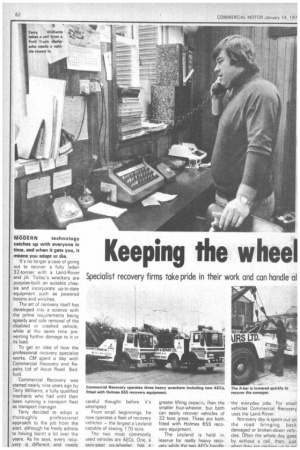Keeping the wheel
Page 64

Page 65

If you've noticed an error in this article please click here to report it so we can fix it.
I recovery moving
Specialist recovery firms take pride in their work and can handle al
'ask. Stephen Gray visits one such firm — Commercial Recovery
MODERN technology catches up with everyone in time, and when it gets you, it means you adapt or die.
It's no longer a case of going out to recover a fully laden 32-tonner with a Land-Rover and jib. Today's wreckers are purpose-built on suitable chassis and incorporate up-to-date equipment such as powered booms and winches.
The art of recovery itself has developed into a science with the prime requirements being speedy and safe removal of the disabled or crashed vehicle, while at the same time preventing further damage to it or its load.
To get an idea of how the professional recovery specialist works, CM spent a day with Commercial Recovery and Repairs Ltd of Ascot Road, Bedford.
Commercial Recovery was started nearly nine years ago by Terry Williams, a fully qualified mechanic who had until then been running a transport fleet as transport manager.
Terry decided to adopt a thoroughly professional approach to the job from the start, although he freely admits to having learnt a lot over the years. As he says, every recovery is different and needs careful thought before it's attempted.
From small beginnings, he now operates a fleet of recovery vehicles — the largest a Leyland capable of towing 170 tons The two most commonly used vehicles are AECs. One, a twin-steer six-wheeler, has a greater lifting capacity than the smaller four-wheeler, but both can easily recover vehicles of 32 tons gross. These are -both fitted with Holmes 655 recovery equipment.
The Leyland is held in reserve for really heavy recovery while the twn AFC.c handle the everyday jobs For small vehicles Commercial Recovery uses the Land-Rover.
Not every day is spent out on the road bringing back damaged or broken-down vehicles. Often the whole day goes by without a call, then, just When thav nre ome, an urgent telephone call ends them out on the first job f the day. Sometimes this ignals the start of a night of on-stop recoveries Commercial Recovery is artunate in having recovery ontacts with a number of large leet operators as well as with
truck dealers. This enables it to keep its recovery vehicles more Or less fully occupied.
While we were there, a Ford dealer rang to arrange for a D Series road sweeper to be collected which had a burnt-out clutch.
We climbed aboard the six-wheeler with Barry, our driver, and within minutes had arrived at the supposed scene of the breakdown. 'Despite a tour of the street, looking at all likely premises, we couldn't find the disabled Ford.
Barry contacted his base on the radio with a request. for more information on the vehicle's position.
Eventually we found the truck, off a different road, in the yard of a plant hire firm.
Using the two powered winches, controlled by two sets of levers on each side of the wrecker, he lowered the 'A' bar and lift and tow hitch. Great care was needed when attaching the chains to . the Ford's front suspension, as the sweeper was fitted with road spraying equipment below the bumper.
About five minutes after we had arrived, however, the sweeper was hooked up and ready to roll. A quick check to ensure that the park brake was off, and the gears in neutral, and we were on our way to deliver it to the Ford dealer.
Of course this recovery was very straightforward, unlike 'some Commercial Recovery has attended in the past. On one occasion, a bulldozer had driven into the oozey mud of the Thames where it sank deeply.
With every high tide, the dozer was covered with water, so recovery could only be attempted at low tide. As well as its own weight, the bulldozer formed a suction effect in the mud and so was twice as difficult to remove.
Nevertheless, Commercial Recovery managed to extract it, although it was a long and difficult task.
Other awkward recoveries included winching a damaged vehicle up from a lower carriageway to the one above on an elevated piece of roadway. It was impossible to gain access to the truck in any other way.
In addition to operating its comprehensive recovery service, Commercial Recovery and Repairs also has a busy workshop facility. Here, all kinds of work are undertaken, including fitting fifth-wheels and ancil-. laries to new tractive units and spray painting.








































































































